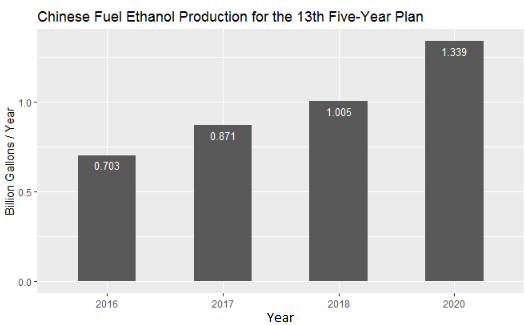As we mentioned in this DIS blog in 2016, the Chinese government indicated that the expected fuel ethanol production will be 4 million Metric tons (1.339 billion gallons) per year during the 13th Five-Year Plan. In 2017, ethanol production stands for 2.6 million tons (0.871 billion gallons) per year, increased 0.5 million tons (0.167 billion gallons) per year, from 2.1 million tons (0.703 billion gallons) in 2016. Currently the ethanol production increased to 3 million tons (1.005 billion gallons) per year, but it still under the expectation. In 2018, the total ethanol production is projected at 3 million tons (1.005 billion gallons).

According to the 13th Five-Year Plan, the Chinese government is planning to invest another 18 billion Yuan (about 2.8 billion dollars) and it indicates several possible ways. First, China may plant more cassava and sorghum in some unproductive lands and waste areas, like saline-alkali land. Second, China will invest vigorously in the development of fiber ethanol, such as producing ethanol from cellulosic fiber, which uses the non-edible parts of plants. Third, China intends to speed use its storage corn to produce ethanol, which will be the main method to increase the fuel ethanol production.
As in the 2016 report, we mentioned this plan has some ramification for the U.S. ethanol and co-product market, when China uses the storage corn to produce fuel ethanol. For example, in Iowa, DDGS’s price was $122/ton in January 2016 and dropped to $93/ton in May 2017, and then rose back to $120/ton at the end of 2017 (Data is from ISU Extension and Outreach).
Based on the 13th Five-Year Plan, they will not only speed up the fuel ethanol production, but also spread out its application. Chinese government indicates that the expected a 10% ethanol blend with gasoline (E10) will be applied all over the country, based on the report from the China Petroleum News Center. It also says, so far, there are 11 provinces required to use fuel ethanol. Six of them, i.e., Liaoning, Jilin, Heilongjiang, Henan, Anhui, and Guangxi, must provide E10 blend gasoline for all the gas stations; while other five provinces, i.e., Jiangsu, Hubei, Hebei, Shandong, and Guangdong, could provide both regular and E10 blend gasoline. Until 2020, Chinese government state to popularize E10 blend gasoline to the whole country.
To achieve the goal, the demand of fuel ethanol could reach 13 million tons (4.35 billion gallons) per year, while the current fuel ethanol production is only 3 million tons (1.005 billion gallons) per year. Therefore, the significance difference between demand and production could lead to a whole new story for the fuel ethanol industry, especially for using storage corn, which is 2.998 billion bushels reported by Xinhua News Agency, 2018 January 22nd.

